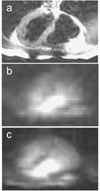Sodium MRI in human heart: a review
- PMID: 25683054
- PMCID: PMC4868405
- DOI: 10.1002/nbm.3265
Sodium MRI in human heart: a review
Abstract
This paper offers a critical review of the properties, methods and potential clinical application of sodium ((23)Na) MRI in human heart. Because the tissue sodium concentration (TSC) in heart is about ~40 µmol/g wet weight, and the (23)Na gyromagnetic ratio and sensitivity are respectively about one-quarter and one-11th of that of hydrogen ((1)H), the signal-to-noise ratio of (23)Na MRI in the heart is about one-6000th of that of conventional cardiac (1)H MRI. In addition, as a quadrupolar nucleus, (23)Na exhibits ultra-short and multi-component relaxation behavior (T1 ~ 30 ms; T2 ~ 0.5-4 ms and 12-20 ms), which requires fast, specialized, ultra-short echo-time MRI sequences, especially for quantifying TSC. Cardiac (23)Na MRI studies from 1.5 to 7 T measure a volume-weighted sum of intra- and extra-cellular components present at cytosolic concentrations of 10-15 mM and 135-150 mM in healthy tissue, respectively, at a spatial resolution of about 0.1-1 ml in 10 min or so. Currently, intra- and extra-cellular sodium cannot be unambiguously resolved without the use of potentially toxic shift reagents. Nevertheless, increases in TSC attributable to an influx of intra-cellular sodium and/or increased extra-cellular volume have been demonstrated in human myocardial infarction consistent with prior animal studies, and arguably might also be seen in future studies of ischemia and cardiomyopathies--especially those involving defects in sodium transport. While technical implementation remains a hurdle, a central question for clinical use is whether cardiac (23)Na MRI can deliver useful information unobtainable by other more convenient methods, including (1)H MRI.
Keywords: MRI; T1; T2; heart; myocardial infarction; quantification; sodium; total sodium content; ultra-short echo time.
Copyright © 2015 John Wiley & Sons, Ltd.
Figures




Similar articles
-
Frontiers of Sodium MRI Revisited: From Cartilage to Brain Imaging.J Magn Reson Imaging. 2021 Jul;54(1):58-75. doi: 10.1002/jmri.27326. Epub 2020 Aug 26. J Magn Reson Imaging. 2021. PMID: 32851736 Free PMC article. Review.
-
Sodium and quantitative hydrogen parameter changes in muscle tissue after eccentric exercise and in delayed-onset muscle soreness assessed with magnetic resonance imaging.NMR Biomed. 2023 Feb;36(2):e4840. doi: 10.1002/nbm.4840. Epub 2022 Nov 5. NMR Biomed. 2023. PMID: 36196511
-
Corrections of myocardial tissue sodium concentration measurements in human cardiac 23 Na MRI at 7 Tesla.Magn Reson Med. 2019 Jul;82(1):159-173. doi: 10.1002/mrm.27703. Epub 2019 Mar 12. Magn Reson Med. 2019. PMID: 30859615
-
ECG-gated 23Na-MRI of the human heart using a 3D-radial projection technique with ultra-short echo times.MAGMA. 2004 May;16(6):297-302. doi: 10.1007/s10334-004-0038-8. Epub 2004 May 24. MAGMA. 2004. PMID: 15160295
-
Sodium MRI: a new frontier in imaging in nephrology.Curr Opin Nephrol Hypertens. 2017 Nov;26(6):435-441. doi: 10.1097/MNH.0000000000000370. Curr Opin Nephrol Hypertens. 2017. PMID: 28877041 Review.
Cited by
-
Uncompromised MRI of knee cartilage while incorporating sensitive sodium MRI.NMR Biomed. 2019 Nov;32(11):e4173. doi: 10.1002/nbm.4173. Epub 2019 Sep 10. NMR Biomed. 2019. PMID: 31502337 Free PMC article.
-
Recent Advances in Sodium Magnetic Resonance Imaging and Its Future Role in Kidney Disease.J Clin Med. 2023 Jun 29;12(13):4381. doi: 10.3390/jcm12134381. J Clin Med. 2023. PMID: 37445416 Free PMC article. Review.
-
Gadolinium-Based Contrast Agents (GBCAs) for MRI: A Benefit-Risk Balance Analysis from a Chemical, Biomedical, and Environmental Point of View.Glob Chall. 2025 Jan 23;9(3):2400269. doi: 10.1002/gch2.202400269. eCollection 2025 Mar. Glob Chall. 2025. PMID: 40071223 Free PMC article. Review.
-
Frontiers of Sodium MRI Revisited: From Cartilage to Brain Imaging.J Magn Reson Imaging. 2021 Jul;54(1):58-75. doi: 10.1002/jmri.27326. Epub 2020 Aug 26. J Magn Reson Imaging. 2021. PMID: 32851736 Free PMC article. Review.
-
Venous contribution to sodium MRI in the human brain.Magn Reson Med. 2020 Apr;83(4):1331-1338. doi: 10.1002/mrm.27996. Epub 2019 Sep 25. Magn Reson Med. 2020. PMID: 31556169 Free PMC article.
References
-
- Barclay JA, Harley EJ, Houghton H. Electrolyte content of rat heart atria and ventricles. Circ Res. 1960;8:1264–1267. - PubMed
-
- Jennings RB, Sommers HM, Kaltenbach JP, West JJ. Electrolyte alterations in acute myocardial ischemic injury. Circ Res. 1964;14:260–264. - PubMed
-
- Cannon PJ, Maudsley AA, Hilal SK, Simon HE, Cassidy F. Sodium nuclear magnetic resonance imaging of myocardial tissue of dogs after coronary artery occlusion and reperfusion. J Am Coll Cardiol. 1986;7:573–579. - PubMed
Publication types
MeSH terms
Substances
Grants and funding
LinkOut - more resources
Full Text Sources
Other Literature Sources
Medical

